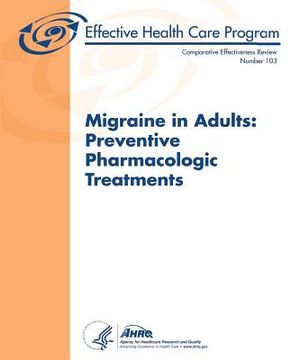Migraine in Adults: Preventive Pharmacologic Treatments: Comparative Effectiveness Review Number 103 (in English)
Synopsis "Migraine in Adults: Preventive Pharmacologic Treatments: Comparative Effectiveness Review Number 103 (in English)"
According to the International Classification of Headache Disorder, migraine is a common disabling primary headache disorder manifesting in attacks lasting 4 to 72 hours. Migraine headaches range from moderate to very severe and are sometimes debilitating. Episodic migraine affects 17 % of women and 6 % of men. Migraine frequency is divided into episodic and chronic. Episodic migraine is characterized by less than 15 migraine days and chronic migraine by 15 or more headache days per month. Sometimes migraine may be described as chronic simply because the attacks recur over long periods of time. Chronic migraine affects 1.4 to 2.2 % of adults. All migraine types significantly affect the physical, psychological, and social well-being of patients, and can impose serious lifestyle restrictions. Each year lost work time and diminished productivity from migraine costs American employers $225.8 billion. Forty percent of adults with episodic migraine and all patients with chronic migraine might benefit from preventive medication; yet, only about 12 % of adults with frequent migraines take preventive medication. Preventive treatments aim to eliminate headache pain without intolerable harms. Often, however, some degree of pain persists; therefore, treatment success is usually defined by a decrease in migraine frequency of 50 % or greater. Preventive treatments are also expected to reduce use of acute drugs and improve quality of life. Treatment safety is defined by the total rates of adverse effects and adverse effects that lead to treatment discontinuation. Drug choices in clinical practice are based on many drug-related factors such as familiarity, efficacy, and adverse effects, as well as many patient characteristics such as headache frequency, presence of aura, comorbid conditions, and patient preference. Our review focuses on the comparative effectiveness and safety of the drugs for preventing migraine attacks in adults; our results can help inform treatment and policy recommendations. By the nature of the question, our review focuses on outpatient care. Key questions addressed include: KQ1: What are the efficacy and comparative effectiveness of pharmacologic treatments for preventing migraine attacks in adults? a. How do preventive pharmacologic treatments affect patient-centered and intermediate outcomes when compared with placebo or no active treatment? b. How do preventive pharmacologic treatments affect patient-centered and intermediate outcomes when compared with active pharmacologic treatments? c. How do preventive pharmacologic treatments affect patient-centered and intermediate outcomes when compared with active nonpharmacologic treatments? d. How do preventive pharmacologic treatments combined with nondrug treatments affect patient-centered and intermediate outcomes when compared with pharmacologic treatments alone? e. How might dosing regimens or duration of treatments influence the effects of the treatments on patient-centered outcomes? How might approaches to drug management (such as patient-care teams, integrated care, coordinated care, patient education, drug surveillance, or interactive drug monitoring) influence results? KQ2: What are the comparative harms from pharmacologic treatments for preventing migraine attacks in adults? a. What are the harms from preventive pharmacologic treatments when compared with placebo or no active treatment? b. What are the harms from preventive pharmacologic treatments when compared with active pharmacologic treatments? c. How might approaches to drug management (such as patient-care teams, integrated care, coordinated care, patient education, drug surveillance, or interactive drug monitoring) influence results? KQ3: Which patient characteristics predict the effectiveness and safety of pharmacologic treatments for preventing migraine attacks in adults?

